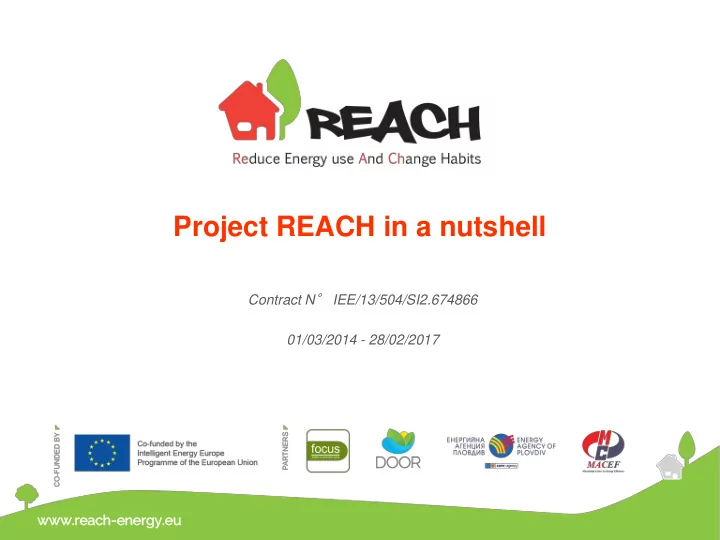

Project REACH in a nutshell Contract N ° IEE/13/504/SI2.674866 01/03/2014 - 28/02/2017 www.reach-energy.eu
Project summary The aim of REACH is to contribute to energy poverty abatement at practical and structural level. Main expected results: • overview of energy poverty situation in 4 countries • 5 workshops for local actors, 5 trainings for teachers and 10 trainings for energy advisors, resulting in 20 engaged local actors, 20 trained teachers and 250 trained energy advisors • 1600 visits of energy poor households, resulting in savings of about 1280 t CO2, 768 toe of energy and 512.000 EUR • 4 national and EU level policy recommendations presented to decision-makers, resulting in 160 decision-makers engaged in tackling energy poverty • action presented to about 500.000 people across EU Partners and countries: • Focus Association for Sustainable Development, Slovenia • Energy Agency of Plovdiv (EAP), Bulgaria • Society for sustainable development design (DOOR), Croatia • Macedonian Centre for Energy Efficiency (MACEF), Macedonia www.reach-energy.eu www.reach-energy.eu
Project background • About 1 in 4 of EU citizens is estimated to be energy poor • Situation is even more severe in the Eastern European Member States, where up to 30 % or even more households are struggling with energy poverty • Energy poverty mostly affects low-income households, whose economic disadvantage is often matched with poor energy efficiency of their homes and linked to poor health • Energy poverty is not perceived as a problem and is hence not being defined and monitored • Reliable data for monitoring the problem is largely missing in the countries, covered by REACH • Existing measures for energy efficiency are not designed to target energy poor households and hence they often fail to provide support for energy poor households • There is serious lack of communication among the energy, social and environmental actors, who should be cooperating closely to address energy poverty • Structural approach to the problem is lacking (energy poverty tailored policies and measures) • Energy poor households are unaware of practical steps to reduce their energy use (and bills) www.reach-energy.eu www.reach-energy.eu
Objectives and main steps The aim of REACH is to contribute to energy poverty abatement at practical and structural level. This aim translates into twofold overall objective of the action, which is a) to empower energy poor households to take actions to save energy and change their habits, and b) to establish energy poverty as an issue that demands structural solutions at local, national and EU level. Main steps to reaching the objectives: • Compiling data and analyzing energy poverty situation in 4 countries, covered by REACH, in order to form definition(s) of energy poverty and policy recommendations • Connecting local actors to tackle energy poverty in 5 pilot areas through joint communication towards energy poor households • Empowering 1600 households to reduce their energy and water use, hence reducing their energy use by averagely 10% and cutting their CO2 emissions by 200 kg/year on average • Engaging 160 decision-makers in tackling energy poverty as an issue that demands structural solutions, providing them with recommendations for addressing the problem and creating a platform for concerted formulation of structural solutions at national and EU level www.reach-energy.eu www.reach-energy.eu
Expected impacts Key outputs • overview of energy poverty for 5 local situations and 4 countries • 1 training for teachers and 2 trainings for energy advisors in each pilot area • 1600 visits with tailor-made reports and advice • 4 sets of national policy recommendations and EU level policy recommendations • advocacy work at national and EU level • report on impacts of visits and advocacy work Key impacts • about 65 representatives of partners and local actors familiar with energy poverty challenges at international and national level and in each pilot area • networks established between at least 5 local actors in each pilot area • 34 persons trained to train energy advisers and 250 trained energy advisors • 1600 households empowered to reduce their energy use and change their habits • 4800 installed energy and water saving devices, resulting in average 10% reduction of energy use and 200 kg/year emissions of CO2 less per visited household • 160 decision-makers familiar with energy poverty challenges and engaged in resolving them www.reach-energy.eu www.reach-energy.eu
Par artners Focus Association for Sustainable Development, Slovenia www.focus.si Co-funded by the Intelligent Energy Europe Programme of the European Union Society for Sustainable Development Design, Croatia P roject REACH is implemented with the financial assistance of the European Union. www.door.hr The contents of this presentation are the sole responsibility of implementing partners and can in no way be taken to reflect the views of Energy agency of Plovdiv, Bulgaria the European Union. www.eap-save.eu For more information about EU: ww w .ec.europa.eu Macedonian Centre for Energy Efficiency, Macedonia www.macef.org.mk www.reach-energy.eu
Recommend
More recommend